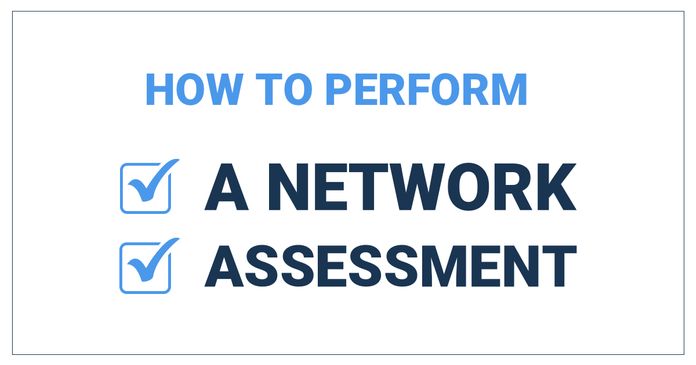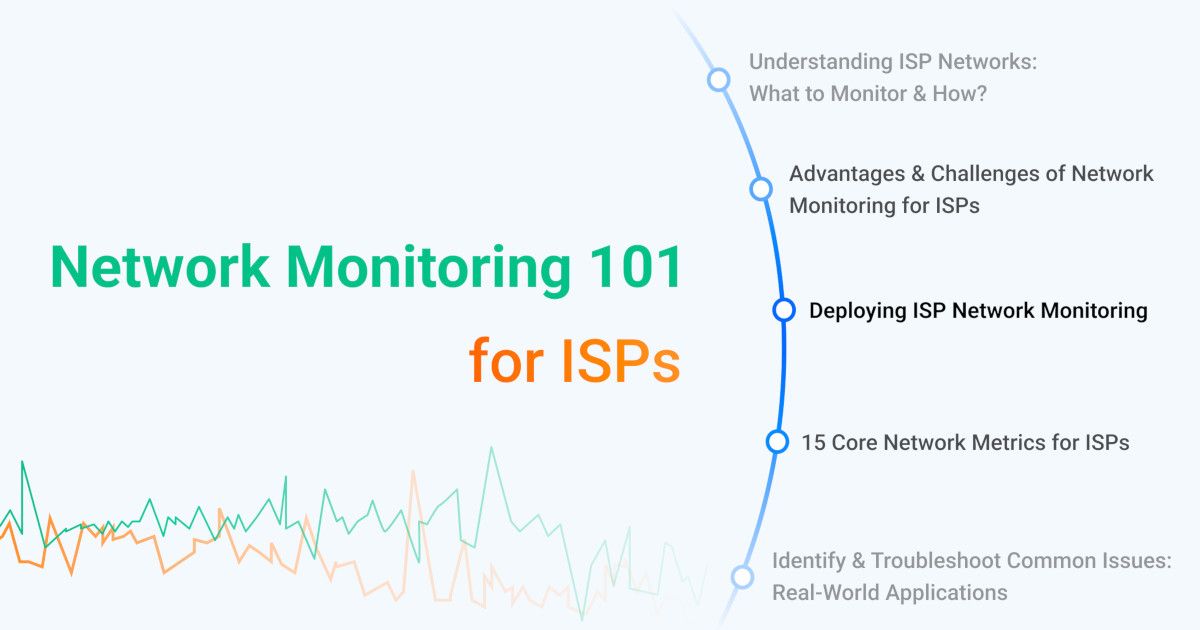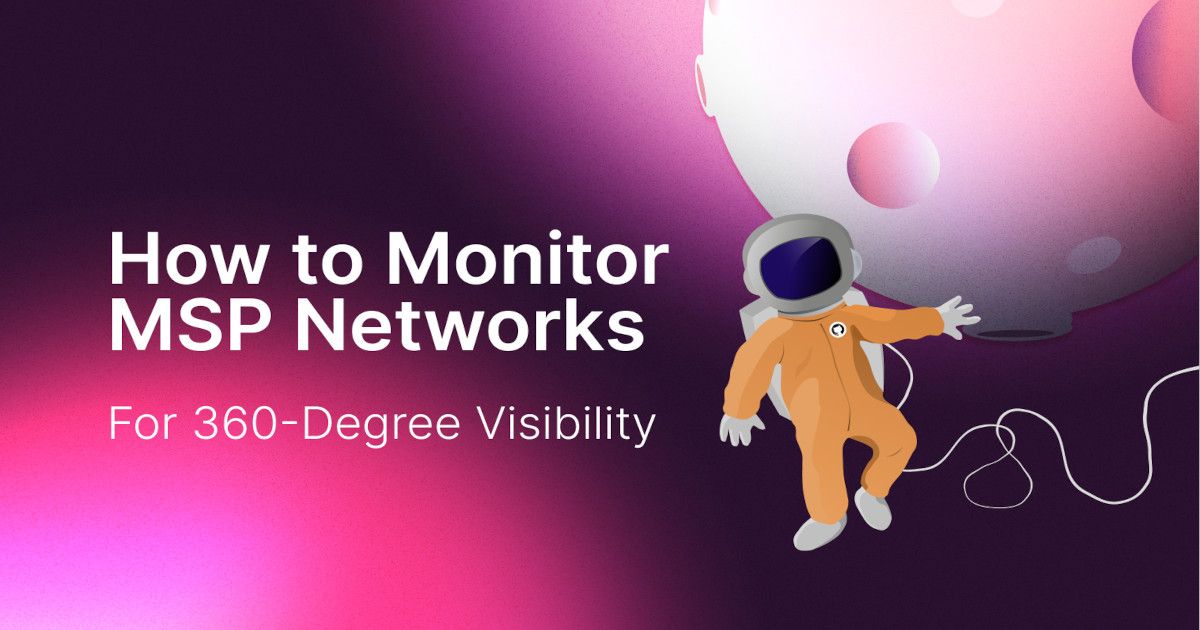Table of Contents
Table of Contents
Voice over Internet Protocol (VoIP) service providers emerge as the architects of seamless and efficient communication. These providers play a pivotal role in facilitating voice and multimedia communication over the Internet, offering cost-effective and feature-rich alternatives to traditional telephony.
The main tasks of VoIP service providers encompass the transmission of voice data, ensuring call quality, and maintaining reliable connections for their clients. However, the challenge lies in identifying the root origin of VoIP issues, which can arise from either the service provider's network or the customer's network. This intricate dance of network performance evaluation requires a nuanced understanding and strategic monitoring to deliver uninterrupted, high-quality VoIP services.
Whether you're a seasoned VoIP veteran or just dipping your toes into the waves of Voice over Internet Protocol, this article will guide you through the murky waters of network monitoring.
As VoIP service providers grapple with significant hurdles when customers encounter performance issues. The dilemma arises when identifying the source of the problem – whether it resides in the provider's network or the customer's network. The pivotal challenge lies in troubleshooting these VoIP performance issues effectively.
VoIP providers need to conduct vigilant monitoring of:
- Entire network performance
- VoIP service across their own as well as customers’ network
Simultaneously, customers also bear the responsibility of monitoring:
- Their own network performance
- VoIP service between their location and the VoIP service provider
In the fast-paced business environment, where every interaction counts, effective communication can be the difference between success and setbacks. A staggering 83% of companies have faced critical consequences due to communication glitches:
- Losing customers
- Missing crucial deadlines
- Parting ways with employees
It's not just a matter of inconvenience, it's a potential roadblock to customer satisfaction, work productivity, and overall employee performance. But fear not, because the right tools can seamlessly integrate communication and collaboration between everyone involved.
Now, imagine your VoIP system as the nerve center of your business conversations – the epicentre of customer interactions and internal collaborations. Monitoring this system isn't just a precautionary measure, it's the key to ensuring it runs smoother than a well-oiled machine, delivering top-notch experiences to your customers.
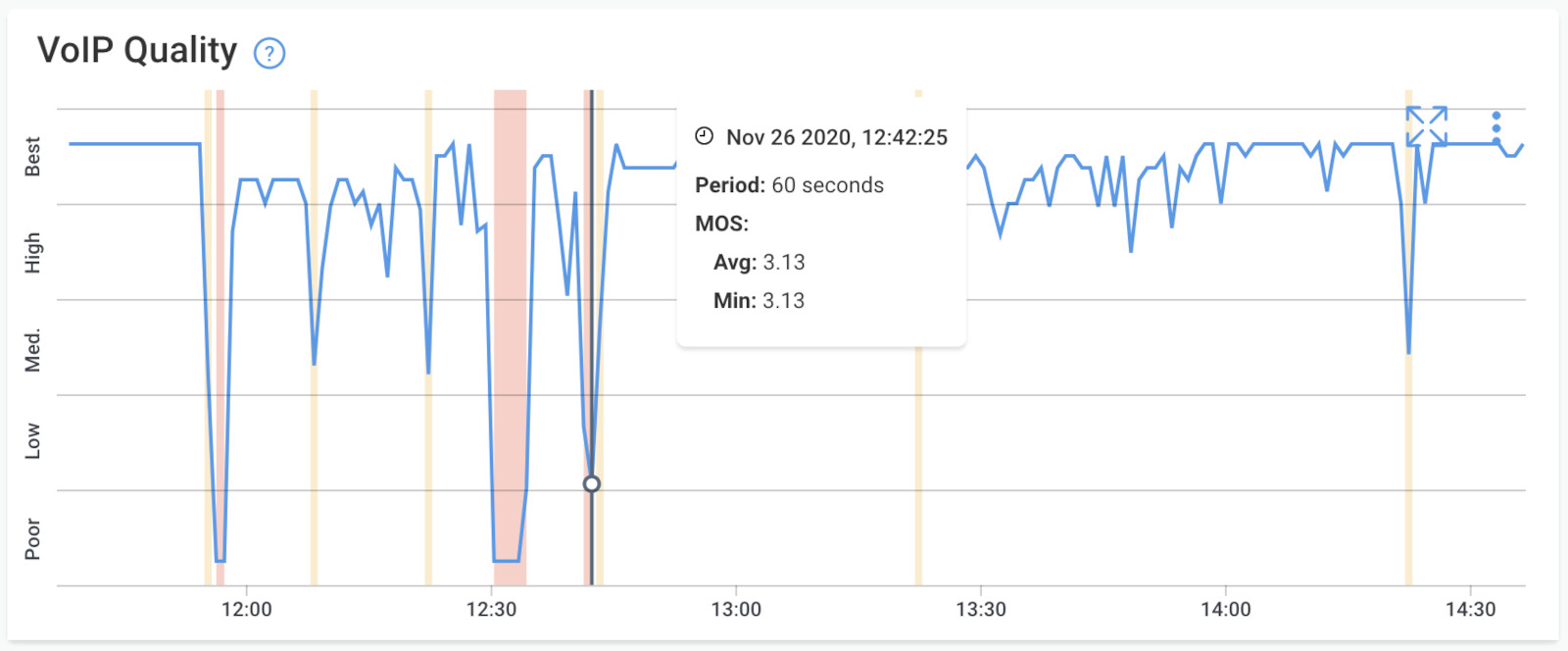

Reducing Downtime: Network congestion, equipment failures, or bandwidth limitations can lead to system downtime. VoIP monitoring tools act as vigilant guardians, detecting and resolving these issues promptly to prevent disruptions to business operations.
Proactive Issue Troubleshooting: VoIP monitoring tools serve as frontline defences, enabling providers to proactively identify and address call quality issues before they escalate into customer dissatisfaction.
Smart Cost-cutting: By optimizing bandwidth usage and identifying faulty equipment, VoIP monitoring tools help providers trim expenses intelligently, keeping their budget in check.
Meeting SLAs (Service Level Agreements): VoIP monitoring assists providers in meeting SLAs, ensuring that they deliver services at agreed-upon performance levels, enhancing customer satisfaction and loyalty.
Enhanced Call Quality: Business customers enjoy an improved call experience, ensuring their interactions with clients and stakeholders are crystal clear and devoid of disruptions.
Boosting Productivity: Clear and consistent communication is imperative for proper business operations. VoIP monitoring software ensures that staff members can communicate clearly and effectively by optimizing the infrastructure.
Insights Into the Cause of VoIP Issues: Customers gain valuable insights into the root of VoIP issues, enabling them to address underlying problems and communicate troubleshooting responsibilities promptly with their service provider.
Getting What They Are Paying For: Business customers can be confident that they receive the service quality they are paying for, ensuring a satisfactory and reliable communication experience.
In essence, monitoring business VoIP phone service providers isn't just a checkbox on the IT to-do list, it's the lifeline for reliant communications. By keeping an eye on call quality and other vital metrics, service providers can proactively tackle issues, streamline operations, and deliver unparalleled service to their customers.

Similar to ISPs and MSPs, VoIP providers encounter challenges not only when their customers face performance issues but also when there are hiccups within their own infrastructure. Employing VoIP Performance Monitoring is a standard practice for evaluating the quality of their services, covering both their internal network and that of their customers.
So, what in the world is VoIP Performance Monitoring? Picture this: your network is a rock band, and VoIP quality monitoring is your backstage crew. It's all about keeping an eagle eye on everything - from how the drummer hits the beat (that’s your call quality) to the lead guitarist shredding without missing a note (that’s your data packets cruising through).
When talking from the techy perspective – VoIP performance monitoring involves the continuous observation and analysis of a Voice over Internet Protocol (VoIP) system's health in real-time, ensuring its optimal functioning. This encompasses the scrutiny of various system aspects, including VoIP quality, network bandwidth, latency, jitter, and packet loss, among other factors.
It becomes essential to use VoIP monitoring tools to find and diagnose problems that could affect call quality, such as poor network conditions, malfunctioning hardware, or software configuration errors. Businesses can protect consumer pleasure by proactively identifying and fixing possible issues with VoIP systems before they affect call quality. This can be done by closely monitoring the system's performance.
Effective VoIP monitoring is a crucial activity for service providers to ensure that VoIP communication runs smoothly for the diverse range of their clients.
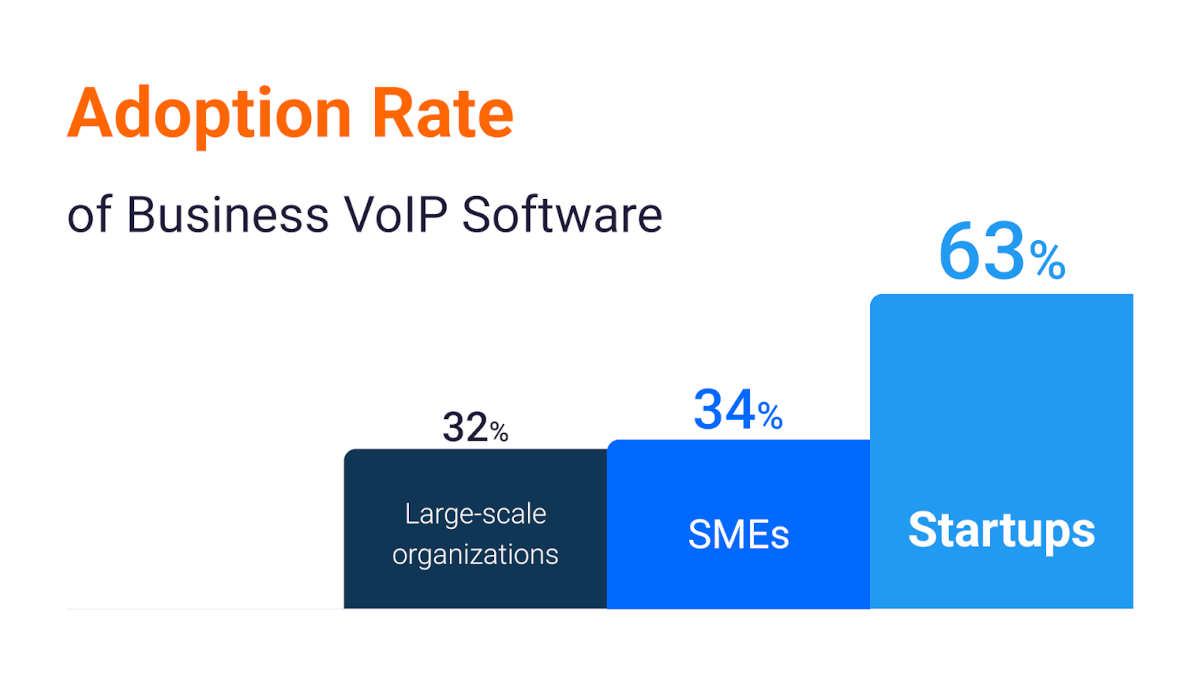
Bid farewell to the woes of choppy calls and welcome the era of crystal-clear conversations, all thanks to the Obkio VoIP Monitoring Tool! Our user-friendly platform is designed to empower you, ensuring your system operates seamlessly, and your calls consistently hit the top tier.
With our toolkit in hand, you gain the superpower to proactively monitor VoIP providers, address issues swiftly, optimize performance, and elevate your communication game.

- 14-day free trial of all premium features
- Deploy in just 10 minutes
- Monitor performance in all vital network locations
- Measure real-time VoIP metrics
- Identify and troubleshoot live network problems
Be assured that Obkio has your back, making sure your VoIP service provider not only meets but exceeds the expectations of your customers.
Let's soar to new heights together!

Defining your VoIP infrastructure as a distinct network entity is akin to wielding a powerful lens that brings clarity to the chaos. Let's delve into the strategic advantages of this approach, unveiling how it empowers network admins to monitor VoIP service providers efficiently.
Imagine having a single panoramic view of VoIP network traffic flows. By defining your VoIP infrastructure as a unique network object, network admins gain a centralized perspective, simplifying the detection of the origins of VoIP traffic. No more tangled threads; just a clear, comprehensive view.
Not all network assets are created equal. By assigning high-value weightings to VoIP-related assets, such as an IP PBX, and VoIP business objects, you can prioritize policies and security incidents. This strategic weighting ensures that critical VoIP elements receive the attention they deserve, minimizing risks and disruptions.
VoIP PBX emerges as a fusion of VoIP and PBX technologies, shorthand for a private branch exchange (PBX), revolutionizing both internal and external communication within an organization. Delving into the nuances, let's explore the distinctive features that set VoIP PBX apart:
1. Technology Fusion:
VoIP PBX seamlessly blends traditional PBX functionalities, encompassing call routing, extensions, and internal communication, with the cutting-edge capabilities of VoIP, allowing voice transmission over the Internet. This integration crafts a holistic communication solution catering to diverse organizational needs.
2. Call Transmission Over the Internet:
Unlike its traditional counterparts, VoIP PBX leverages the Internet to transmit voice calls, transforming voice signals into data packets for seamless transmission. This departure from conventional phone lines enhances efficiency and aligns with the modern shift toward digital communication.
3. Enhanced Flexibility:
VoIP PBX introduces a new era of flexibility, empowering users to initiate calls from an array of devices such as computers, smartphones, and specialized VoIP phones. This versatility ensures communication adapts to the dynamic nature of contemporary work environments.
4. Cost-Effective Solutions:
Cost efficiency takes center stage with VoIP PBX, leveraging existing data networks and minimizing the reliance on separate voice infrastructure. This not only streamlines communication but often proves more economically viable compared to traditional PBX systems.
5. Unified Communication Platform:
VoIP PBX transcends mere voice calls, encompassing a spectrum of communication features. From voice and video conferencing to instant messaging and voicemail, it aspires to create a unified communication platform that caters to diverse modes of interaction within the organization.
In the labyrinth of technical or security issues, time is of the essence. Defining VoIP infrastructure allows for quick filtering and searching of VoIP traffic flows and associated security logs. This efficiency becomes a troubleshooting ally, aiding administrators in swiftly identifying and addressing VoIP-related challenges.
VoIP networks have unique behaviours, much like living organisms. Defining your VoIP infrastructure enables administrators to study and understand these behaviours, facilitating the rapid establishment of appropriate policies. It's not just about fixing issues; it's about shaping a proactive and responsive VoIP environment.
The power of data lies in its presentation. With a defined VoIP infrastructure, generating executive and operations-level reports becomes a streamlined process. These reports not only provide insights into VoIP security but also offer a snapshot of network usage. In the realm of decision-making, information is not just power; it's a strategic advantage.
Unlock the secrets of VoIP monitoring! Discover tools, techniques, and the power of Obkio for unbeatable call quality. Begin your adventure today!
Learn more

Uncovering the Mechanism: How VoIP Monitoring Software Ensures Seamless Calls for VoIP Service Providers & Customers
VoIP monitoring software is not merely another tool in your technical kit, it's a comprehensive solution fostering a collaborative ecosystem where performance is monitored and enhanced from both perspectives. This promises a communication landscape that is resilient, efficient, and tailored to the expectations of VoIP service providers and their customers.
Let's peel back the layers and explore the intricacies of VoIP monitoring software – the unsung hero in the realm of voice communication.
Think of it as the heartbeat of your VoIP system. VoIP monitoring software keeps a vigilant eye on network latency, jitters, and packet loss in real-time. By ensuring efficient network performance, it forms the backbone of uninterrupted voice conversations.
In the realm of network traffic, foresight is the key to harmony. VoIP Service Providers, armed with advanced monitoring tools, can analyze traffic patterns comprehensively. This strategic analysis acts as a crystal ball, predicting congestion before it casts its shadow on VoIP quality.
Now, let's dive into the DNA of VoIP applications. The software captures and analyzes data, including server response time and application response time. This deep dive helps identify and troubleshoot issues specific to VoIP applications, ensuring they run like a well-oiled machine.
Software-Defined Wide Area Networking (SD-WAN) emerges as a game-changer, offering a remedy for network congestion through strategic traffic routing and load balancing. This innovative approach involves the dynamic allocation of network resources, finely tuned to meet the specific requirements of individual applications, ultimately ensuring peak performance for VoIP calls.
Key Insights:
1. Intelligent VoIP Traffic Routing:
By implementing SD-WAN, you empower your network to intelligently route VoIP traffic. This strategic maneuver ensures that voice calls take the most efficient path, avoiding bottlenecks and guaranteeing a seamless communication experience.
2. Load Balancing:
Network traffic, much like a symphony, requires balance. SD-WAN introduces load balancing, a conductor orchestrating the distribution of traffic across multiple network connections. This harmonious approach prevents any single connection from bearing the brunt, optimizing the overall efficiency of your network.
Here's where the software spreads its wings. It doesn't just stop at VoIP; it extends its gaze to manage various communication systems. By collecting and analyzing data from diverse resources, it provides a comprehensive view of the entire system's performance, creating a symphony of communication efficiency.
84% of businesses report that the adoption of unified communications translates to elevated employee productivity, heightened business agility, and enhanced flexibility. This statistic unveils the transformative power that unified communications brings to businesses, paving the way for a more dynamic and agile operational landscape.
Learn how to measure VoIP Quality using MOS Score (Mean Opinion Score) & Obkio’s VoIP monitoring solution to identify poor VoIP Quality issues & dropped calls.
Learn more

Ever encountered a call that sounds like it's underwater or full of echoes? VoIP monitoring software tackles these issues head-on. It monitors individual VoIP calls, measuring crucial metrics that are the pulse of call quality.
MOS (Mean Opinion Score): The benchmark for VoIP quality assessment lies in the MOS. This is a standardized rating system to evaluate the quality of a voice call. MOS scores are meticulously calculated through subjective ratings provided by human listeners, who assess factors such as clarity, background noise, and echo.
To derive the MOS score, a group of individuals listens to a set of standardized audio samples, assigning ratings on a scale from 1 to 5. The scale represents the spectrum from the lowest quality (1) to the highest (5). The culmination of these individual ratings results in an averaged MOS score, providing a comprehensive measure of the overall voice quality in VoIP communication.
R-Factor: The R-factor stands as an objective metric, meticulously gauging the quality of voice calls. This metric factors in crucial elements like delay, jitter, and packet loss, ultimately generating a score within the range of 0 to 100. The R-factor operates on a simple principle: the higher the score, the better the call quality. This numeric evaluation becomes a decisive measure, offering insights into the overall quality of VoIP calls.
Packet Loss Rate: This rate represents the percentage of voice packets that face loss during transmission. The implications are clear: a higher packet loss rate directly correlates with diminished call quality. As a pivotal aspect of transmission reliability, monitoring and minimizing packet loss become paramount for ensuring a seamless and high-quality VoIP communication experience.
Latency: Latency takes center stage as the delay between sending and receiving a voice packet. This delay, while seemingly innocuous, holds significant sway over call quality. When latency climbs to higher levels, it becomes a potential harbinger of poor call quality, disrupting the seamless flow of communication. Understanding and addressing latency become key components in ensuring a smooth and high-calibre VoIP calling experience.
Echo: The phenomenon known as "echo" takes center stage, manifesting when a caller hears their own voice reflected in their earpiece. This peculiar occurrence, akin to a vocal déjà vu, can be attributed to various factors such as network delays and insufficient echo cancellation mechanisms. The repercussions are clear – the presence of echo introduces an unwelcome element of poor call quality, emphasizing the need for robust solutions to mitigate its effects and ensure a pristine VoIP communication experience.
Time to dissect the language for business VoIP phone service providers. The software captures and analyzes data related to call signals and media streams. This ensures that the VoIP protocol functions effectively and efficiently, laying the groundwork for smooth communication.
Quality of Service (QoS) emerges as a virtuoso, wielding a critical role in overcoming the challenges posed by congestion. By strategically prioritizing VoIP traffic over other data packets, QoS orchestrates a seamless delivery of voice packets, ensuring users experience uninterrupted communication even amidst peak traffic periods.
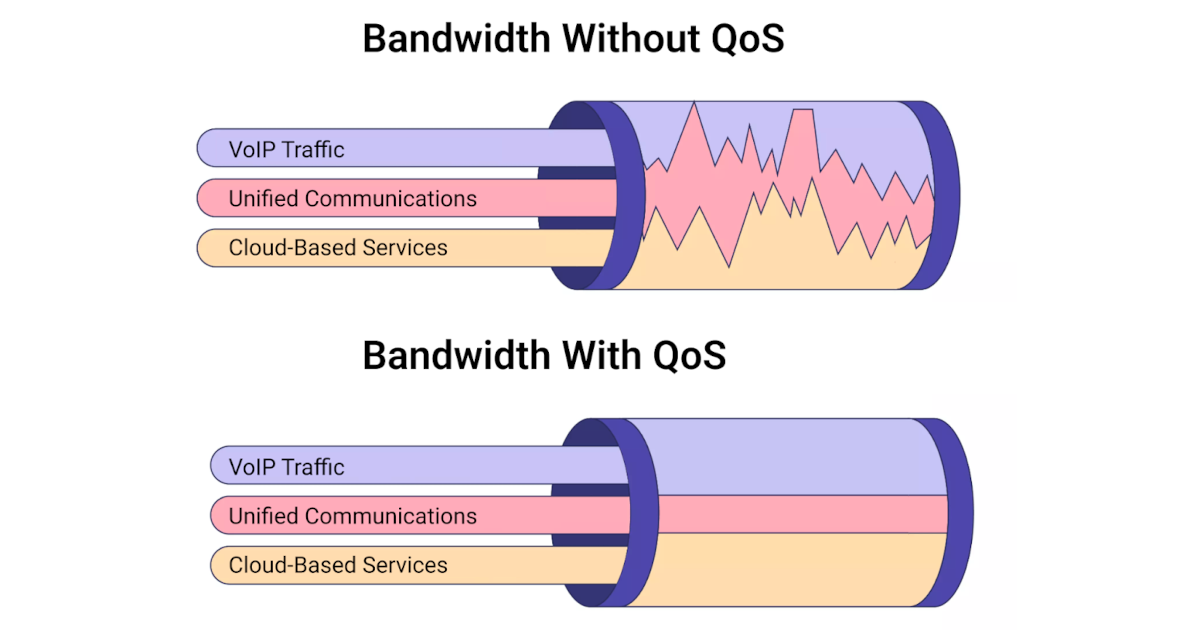
Key Insights:
1. Prioritizing VoIP with QoS Policies:
Think of QoS as the conductor of your network symphony. Implementing QoS policies across routers, switches, and firewalls becomes the key to prioritizing VoIP traffic. This strategic maneuver ensures that voice packets take the express lane, bypassing potential traffic jams and reaching their destination promptly.
2. Bandwidth Allocation for Smooth VoIP Delivery:
In the bandwidth orchestra, every instrument plays a crucial role. QoS assigns appropriate bandwidth for VoIP traffic, guaranteeing a smooth and uninterrupted delivery. This intentional allocation ensures that voice communication remains crystal-clear, regardless of the traffic volume surges during peak periods.
Obkio's got your back, and we're talking about a deployment process that's as easy as ordering your favourite takeout.
It's like plug-and-play but for monitoring the performance and reliability of the VoIP Provider's Network as a whole to understand where issues are coming from. So, if you're ready to make sure your calls are smoother than a jazz melody, let's roll up our sleeves and see how Obkio's got simplicity down to an art.

Obkio provides an extensive array of robust features that are incorporated into a dedicated VoIP Monitoring tool. It empowers service providers to effortlessly gauge and track VoIP quality metrics in real-time, offering valuable insights into performance while enabling swift identification and resolution of issues.
The significance of network performance in determining VoIP quality cannot be overstated. In VoIP calls, voice data traverses the Internet, and any network-related issues can result in delays, packet loss, and other complications that directly impact call quality. Hence, monitoring both network and VoIP quality concurrently is imperative.
Monitor VoIP service provider with Obkio, where the measurement of VoIP quality through the MOS score becomes a proactive process. This tool allows for the early identification and troubleshooting of VoIP issues before end-users experience any disruptions. The intuitive interface and real-time monitoring capabilities of Obkio simplify the task of maintaining a seamlessly operating VoIP system, ensuring the highest standard of call quality.


To ensure seamless VoIP monitoring across all your network locations and core VoIP applications, the deployment of Network Monitoring Agents is paramount. These agents work tirelessly to continuously measure network performance in key locations such as offices, data centers, and clouds.
Engaging in the exchange of synthetic traffic amongst themselves, these Agents focus on measuring core network metrics crucial to effective VoIP monitoring. Metrics include the MOS score, VoIP Quality, packet loss, jitter, and more.
To gather the necessary data for analysis and translation, the following components are essential:
- Local Agents: Positioned strategically in specific office locations experiencing VoIP Quality challenges, Local Agents come in various types, all equipped with identical features. They can be effortlessly installed on diverse operating systems like MacOS, Windows, Linux, and more.
- Public Monitoring Agent: These agents are deployed over the Internet, and centrally managed by Obkio. Serving as the bridge between the local environment and the broader Internet, Public Monitoring Agents play a pivotal role in comparing network and VoIP performance. They are instrumental in monitoring VoIP Quality for applications like Microsoft Teams and Zoom, aiding in the identification of whether network and VoIP issues are global or confined to specific destinations.
VoIP providers face the challenge of managing not only their own networks but also gaining visibility into their clients' networks to discern service issues. Overcome this complexity and provide impactful solutions by deploying Monitoring Agents across all your client's networks.
This proactive step enhances network performance and troubleshooting capabilities. Adopt a strategic deployment approach within each client's network, where the agents monitor network performance, translating data into comprehensive reports and visualizations for informed decision-making:
- Eliminate the guesswork
- Accelerate the identification and resolution of issues
- Fosters a deeper sense of partnership between you and your clients
The deployment of Monitoring Agents in your clients' networks positions you as a forward-thinking, technology-savvy partner invested in their success, empowering them with tangible data about their network health.

Once your Monitoring Agents are strategically deployed, they seamlessly initiate the exchange of synthetic traffic to delve into VoIP Quality assessments.
For many years, the most widely used statistic to assess the general quality of phone calls has been the Mean Opinion Score or MOS Score. The International Telecommunications Union (ITU-T) has standardized the MOS Score, which stands for:
A numerical measure of the human-judged overall quality of voice and video sessions.
In the MOS assessment, human participants engage in listening to a series of pre-recorded speech samples or take part in live VoIP calls. Following each sample or call, participants are required to rate the voice quality on a scale ranging from 1 to 5, where 5 signifies excellent quality and 1 denotes an unacceptable level. The averaged ratings provided by the participants are then utilized to compute the overall Mean Opinion Score for the respective VoIP call or service.
Various factors are taken into consideration during the MOS test, influencing the voice quality, such as:
- Clarity: Evaluating the voice's ability to be heard clearly and distinctly, free of noise or distortion.
- Loudness: Assessing if the voice stays within a reasonable range of volume, staying away from extremes of either too loud or too quiet.
- Delay: Determining the latency, or amount of time it takes for a voice to be heard after speaking.
- Jitter: Analyzing the fluctuations in packet delays, which can cause choppy audio.
- Packet Loss: Analyzing the proportion of voice packets lost during transmission that result in audio gaps is known as measuring packet loss.
- Background Noise: Determining whether there is any unwelcome background noise or interference during the call.
The MOS test produces a singular score that offers a concise summary of the VoIP call quality. This score is invaluable for VoIP service providers and network administrators, providing essential insights into how users perceive the quality of their VoIP service. A higher MOS score signifies superior voice quality and a more satisfactory user experience.
Obkio’s MOS VoIP Quality graph diligently categorizes the MOS Call Quality every minute, providing insights into the VoIP experience. In broad strokes, a MOS score of 4 or above is hailed as high-quality audio, reflective of a commendable VoIP experience. This implies that users perceive the audio quality as akin to that of a traditional phone call.
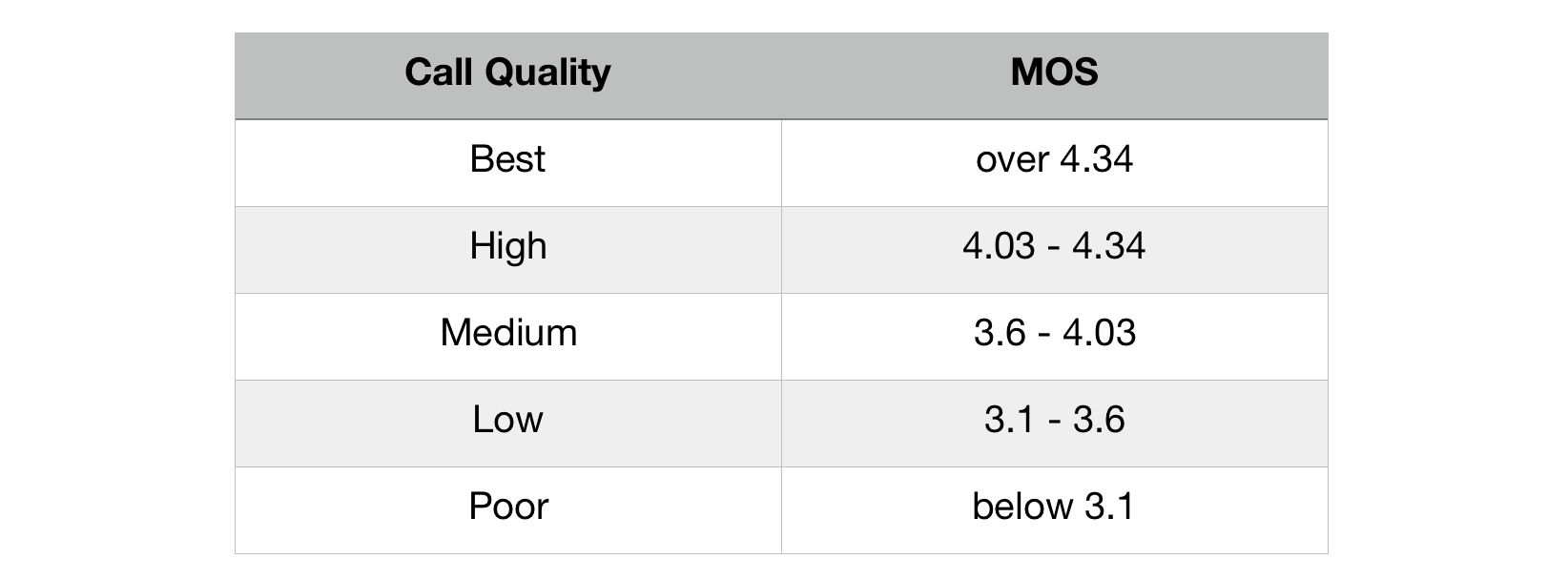
Conversely, a MOS score falling below 3 is earmarked as low-quality audio, signalling a subpar VoIP experience. This manifests as distorted, choppy, or robotic-sounding audio, presenting challenges for users in comprehending the conversation.
Overall, striving for a high MOS rate stands pivotal in delivering a stellar VoIP experience, ensuring users' contentment with the audio quality of their calls.
Following the strategic deployment of Obkio Monitoring Agents across your pivotal network locations, these vigilant agents kickstart the measurement of critical VoIP network metrics indispensable to both your network and VoIP performance.
VoIP service providers gain the capability to track pivotal performance metrics, including latency, jitter, packet loss, R-factor, MOS score and more. This proactive approach allows for the early detection and resolution of issues that might otherwise tarnish the call quality.
By closely monitoring these metrics, businesses can ensure that their VoIP systems operate at peak performance, guaranteeing users the best possible experience.
Latency, jitter, and packet loss are the adversaries we must face to ensure smooth communication. So, let's put on our virtual armour, grab our swords of network insights, and charge into the challenges that threaten to disrupt the harmony of VoIP service performance.

VoIP Latency: Picture this: your customer is in the middle of an important call, and suddenly, awkward pauses and people talking over each other hijack the conversation. That's the work of latency, the silent time thief. Ideally, it should be under 150 milliseconds, but when it stretches beyond 250ms, chaos begins. While some latency is beyond your control, aim for internal network latency under 150ms for a smoother end-user communication experience.
VoIP Jitter: Jitter is the nasty sibling of latency, measuring the inconsistency in the arrival of packets. To maintain order, you want an internal network jitter under 100ms. This ensures that your packets arrive at their destination in the right order, preventing a communication symphony from turning into a cacophony.
VoIP Packet Loss: Enter packet loss, the saboteur of smooth communication. Even a 1% packet loss can wreak havoc on real-time protocol (RTP) codecs, leading to choppy audio. VoIP is particularly susceptible, and the aftermath might include lost productivity, abruptly ended calls, and, in extreme cases, headsets meeting their demise in fits of frustration.
Now, armed with an understanding of these villains, let's explore how to triumph over them.


1. Network Complexity:
Modern networks are a maze of architectures, making VoIP monitoring a puzzle. To navigate this complexity, opt for VoIP monitoring tools that provide comprehensive visibility and support multiple protocols. This ensures a clear view across the entire network, simplifying the monitoring process.
2. Intermittent Network Problems:
VoIP monitoring becomes a detective game when issues pop up sporadically. Combat this by adopting real-time monitoring solutions, capturing and analyzing data at frequent intervals. This way, even the sneakiest intermittent issues won't escape your vigilant gaze.
3. Network Congestion:
Congestion, the arch-enemy of call quality. Defeat it by implementing Quality of Service (QoS) mechanisms, and prioritizing VoIP traffic. Regularly monitor traffic patterns and bandwidth usage to spot congestion points and take swift action.
4. Variable Network Conditions:
VoIP calls travel through diverse networks. Combat this challenge by deploying monitoring agents in multiple locations. This broader perspective helps identify issues specific to certain networks or locations, ensuring a consistent VoIP experience.
5. Codec Variations:
Codecs, the diverse personalities of VoIP calls. Ensure your monitoring tools understand and manage the specific codecs in use. This way, you can maintain call quality, regardless of the codec throwing its unique flavour into the mix.
6. End-to-end Visibility:
VoIP calls are a symphony of components. Ensure end-to-end visibility (LAN to WAN) by implementing monitoring solutions that dive into each component. This allows for thorough troubleshooting and reveals any performance bottlenecks affecting call quality.
7. Scalability:
As your VoIP empire grows, scalability is key. Choose monitoring solutions that can handle the increasing traffic, providing accurate metrics for every call. Scalability ensures your monitoring system grows as your VoIP kingdom expands.
Armed with these insights, you're ready to tackle the challenges of VoIP monitoring like a seasoned warrior. As we continue our quest, keep these insights in your arsenal, and let's pave the way for crystal-clear conversations in the dynamic world of VoIP networks. Onward!
Understanding and addressing VoIP performance issues are paramount for both Service Providers and their valued customers. Monitoring network and VoIP performance serves as the cornerstone for uncovering the root causes of disruptions and ensuring seamless communication experiences.
Maintaining optimal performance is paramount for client satisfaction and meeting Service-Level Agreements (SLAs). This step focuses on leveraging VoIP Service Provider Network Monitoring to scrutinize the service provider's network, ensuring that potential VoIP issues are identified and addressed proactively.
Service providers must maintain a transparent view of their own network to uphold the commitments outlined in SLAs. VoIP Service Provider Network Monitoring acts as the lens, offering real-time insights into crucial metrics such as latency, packet loss, and overall VoIP quality. By vigilantly monitoring these parameters, service providers can detect and address issues before they escalate, preserving the integrity of their VoIP services.
Identifying VoIP issues within the service provider's network allows for a proactive stance in issue resolution. Through continuous monitoring, potential disruptions and performance bottlenecks can be addressed swiftly. This proactive approach not only enhances service provider credibility but also aligns with the goal of delivering uninterrupted and high-quality VoIP services.
Service providers often operate within the framework of SLAs that define the expected level of service. VoIP Service Provider Network Monitoring generates data-driven insights that can be used to demonstrate compliance with SLAs. The ability to showcase a commitment to meeting and exceeding performance benchmarks fosters trust and satisfaction among clients.
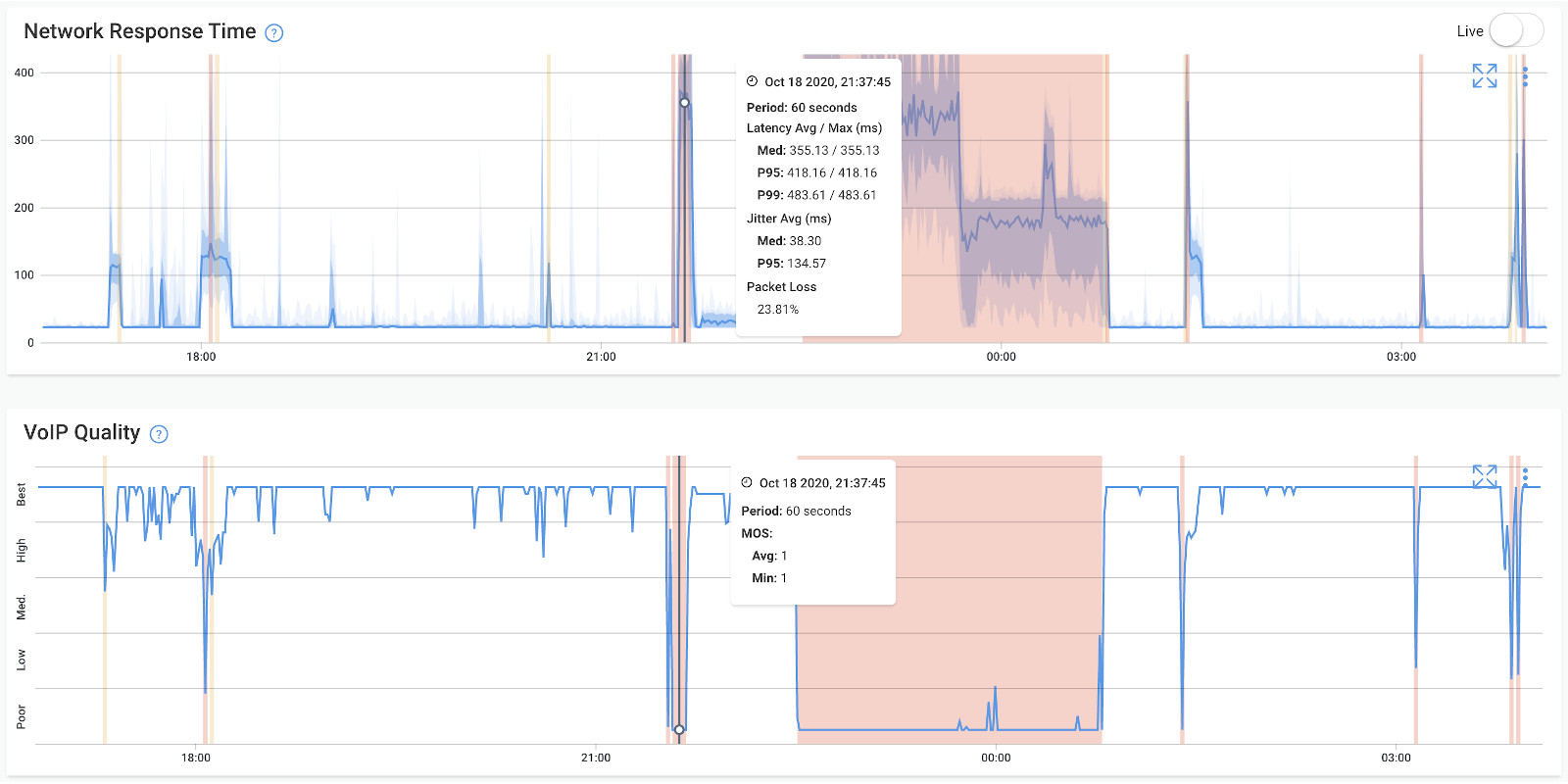

Understanding that VoIP performance issues may originate from either the service provider's network or the customer's network is crucial. This step delves into the process of utilizing VoIP Service Provider Network Monitoring to assess and troubleshoot VoIP issues within the customer's network, facilitating collaborative issue resolution.
Collaborative Troubleshooting
VoIP Service Provider Network Monitoring serves as a collaborative tool, offering real-time insights into the customer's network. In scenarios where VoIP issues are reported, service providers can work collaboratively with clients to pinpoint the root cause. This joint effort streamlines the troubleshooting process and reinforces the partnership between the service provider and the customer.
Customer Empowerment through Data
Empowering customers with tangible data about their network health is a key aspect of VoIP Service Provider Network Monitoring. Clients gain access to comprehensive reports and visualizations, enabling them to take proactive measures to maintain optimal network performance. This transparency fosters effective collaboration and ensures that customers are actively engaged in the troubleshooting process.
Efficient Issue Resolution
Identifying VoIP issues within the customer's network allows for efficient issue resolution. Service providers armed with real-time insights can guide customers in addressing network challenges on their end. This collaborative resolution strategy ensures that VoIP issues are tackled swiftly, minimizing downtime and enhancing overall customer satisfaction.
In the dynamic landscape of VoIP and IP telephony services, Obkio emerged as a game-changer for three industry leaders: BeeVox, ThinkTel, and Amplisys.
The common thread across these success stories lies in how Obkio transformed VoIP monitoring, ensuring optimal performance and customer satisfaction.
Let's delve into the unified benefits experienced by these service providers:
- BeeVox: By leveraging Obkio, BeeVox gained the ability to proactively identify and address potential network issues before they could impact VoIP services. This proactive stance significantly enhanced the reliability of their cloud communications platform.
- ThinkTel: ThinkTel's pursuit of efficient network assessments found a robust solution in Obkio. The platform's Real Time Media assessment capability empowered ThinkTel to identify and rectify network issues in advance, ensuring a seamless deployment of Unified Communication services.
- Amplisys: Amplisys, equipped with Obkio's continuous monitoring, transitioned from a reactive to a proactive troubleshooting approach. They could identify and address performance issues even before customers reported them, streamlining their support process.

- BeeVox: Obkio's end-to-end monitoring provided BeeVox with comprehensive visibility into network performance, allowing them to maintain a robust and reliable VoIP service for their extensive user base.
- ThinkTel: ThinkTel's focus on Real Time Media assessment was complemented by Obkio's ability to offer detailed metrics affecting UC apps. The platform's end-to-end monitoring ensured that ThinkTel had a holistic view of their clients' network performance at all times in real-time.
- Amplisys: With Obkio's Agents deployed for all clients, Amplisys achieved 360-degree visibility into customer networks. This comprehensive view enabled them to identify and troubleshoot performance issues efficiently.
- BeeVox: Obkio played a pivotal role in BeeVox's troubleshooting process, allowing them to swiftly diagnose and resolve issues. Our platform became an invaluable tool for maintaining uninterrupted service quality.
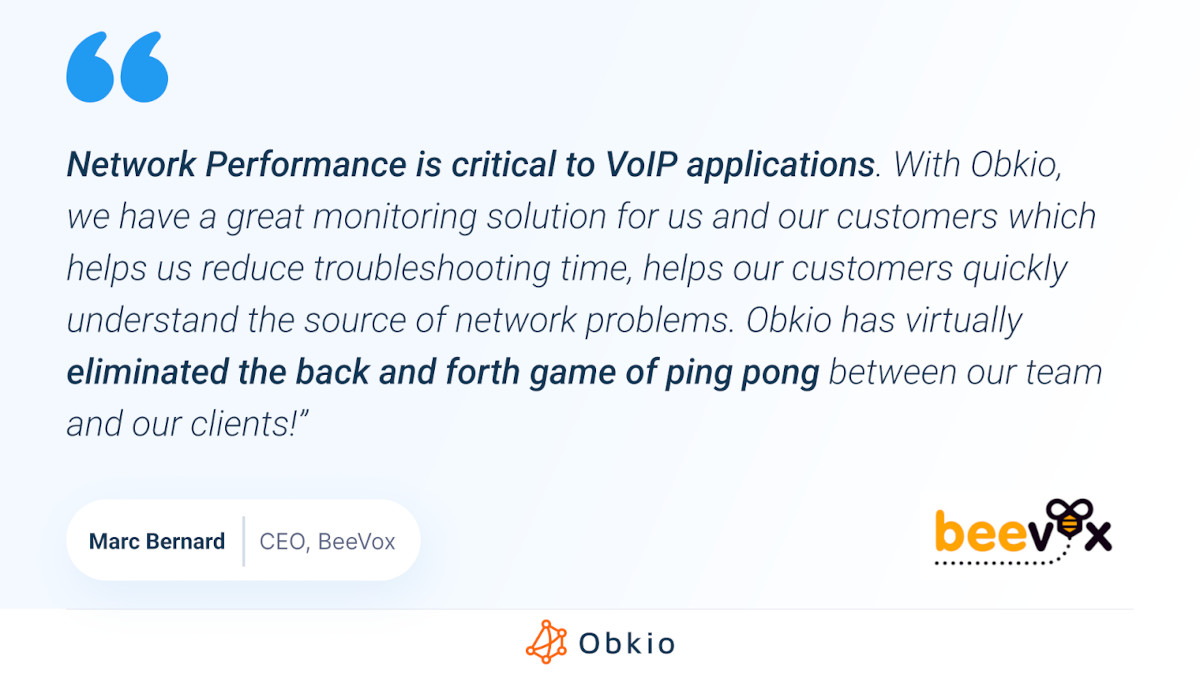
- ThinkTel: For ThinkTel, Obkio's solution became an integral part of their Real-Time Media assessment, streamlining the identification and resolution of network issues. The efficiency gained in troubleshooting enhanced the overall deployment experience for their clients.
- Amplisys: Amplisys integrated Obkio to streamline their support process, automating VoIP monitoring and identifying issues faster. The platform's features, including Traceroutes and Device Monitoring, provided crucial data for efficient troubleshooting.
- BeeVox: Prior to deploying new services, BeeVox benefited from Obkio's capabilities in assessing network readiness. This ensured that the network could meet the demands of their cloud communications platform.
- ThinkTel: Obkio's Real Time Media assessment served as a proactive measure for ThinkTel, allowing them to validate network performance before deploying Microsoft Teams and Skype for Business, mitigating risks associated with UC deployment.
- Amplisys: Amplisys utilized Obkio for pre-deployment network assessments, optimizing network performance for VoIP services. The platform's role in ensuring a smooth service deployment showcased its significance in the overall network management strategy.
Learn how to perform a network assessment with Obkio Network Monitoring to optimize network performance for a new service deployment or migration.
Learn more

- BeeVox: Obkio's continuous monitoring empowered BeeVox to uphold optimal performance, ensuring a reliable and satisfying user experience for their clientele.
- ThinkTel: Beyond pre-deployment assessments, ThinkTel and their clients leveraged Obkio for continuous monitoring. This ongoing observation of network metrics post-deployment ensured sustained high performance.
- Amplisys: With Obkio as a full-time team member, Amplisys achieved continuous end-to-end visibility. The platform's role in continuous monitoring allowed Amplisys to maintain high VoIP Quality consistently.
Obkio's impact on VoIP monitoring is evident across these diverse case studies. Whether it's proactive issue identification, comprehensive visibility, streamlined troubleshooting, pre-deployment assessments, or continuous monitoring, Obkio has proven to be an indispensable tool for enhancing VoIP services.
Ready to revolutionize your VoIP performance monitoring and join the ranks of industry leaders like BeeVox, ThinkTel, and Amplisys? Start your free trial with Obkio today!

- Proactive identification of network issues
- End-to-end visibility into VoIP service performance
- Streamlined troubleshooting process
- Continuous monitoring that ensures top performance and customer satisfaction
- 14-day free trial of all premium features
- Deploy in just 10 minutes
Don't just monitor, elevate your VoIP services with Obkio!


























 Obkio Blog
Obkio Blog







